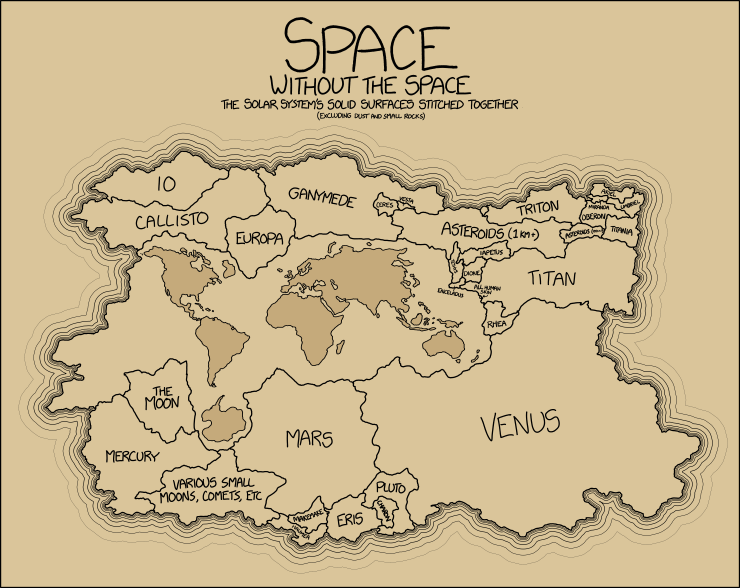Thursday, July 10, 2014
How Big Are The Solid Planets? A Handy Illustration
This excludes Neptune, Saturn and Jupiter, which lack solid surfaces, but includes Moons and minor planets. It is remarkable how much of the solid surface of our solar system is on Earth. Other bodies in the solar system are surprisingly small.
This also illustrates some of the limits to accommodating an expanding human population by settling space. Very thinly inhabited parts of the surface of Earth like the Sahara desert, Antarctica, the Australian Outback, Siberia, and the surfaces of the oceans are much more attractive places to live than anyplace that is not on Earth.
Subscribe to:
Post Comments (Atom)

2 comments:
Very visual, thanks.
I agree that outer space colonization is not going to be anything but science fiction for the next many many centuries - and that therefore we must focus on stabilizing Earth instead, restoring it to sustainability.
I was watching yesterday a documentary on the Mediterranean sea life, which compared today's near-desert underwater images with the abundance of the 1940s and 50s, when Jacques Cousteau began exploring and filming under the sea, and it was really depressive. Overfishing is destroying it all and, while marine reserves obviously do work, there are just way too few of them (just four in all the Western Mediterranean).
This is just the proverbial tip of the iceberg, of course: the environmental problems we face at global scale are many more and demand urgent solutions. Otherwise even living on old good Earth may become impossible soon.
"[W]e must focus on stabilizing Earth instead, restoring it to sustainability."
Absolutely. And, the collapse of marine life is an excellent example which few people realize is as profound as it actually is. One of the mysteries of economics in my mind is why wild caught fish prices haven't skyrocketed to levels much higher than we see today. I am somewhat less pessimistic than some people, overall, however.
For example, Dan Brown's latest novel, "Inferno" features a mad scientist trying to kill off more than half the population of the planet with a plague to avoid Malthusian horrors. But, one of the big lessons of the 20th century is that population growth declines and that populations even shrink with more economic development - something that Roman Catholic Italy in which Brown's book is set, despite the fact that the nation's predominant religion officially rejects most forms of birth control, exemplifies. As a result, global population projections call for a leveling off of world population at 10-12 billion, rather than continued exponential growth.
Similarly, while carbon emissions are surely causing man made global warming and international environmental treaties are unlikely to curb this in time to prevent substantial warming from taking place, peak oil is likely to interrupt the trend before it makes Earth completely uninhabitable. Along the same lines, the UK reached "peak stuff" (i.e. peak consumption of energy and physical goods) sometime within the past few years.
Also, while global warming will make some places on Earth less habitable, it will make others like Arctic Scandinavia, Siberia, Alaska, Northern Canada, and Tibet more habitable. And, we certainly have the technology to live reasonably civilized modern lives, even without mineral source petroleum, in many places like deserts, tundra, and oceans, than we actually do. Hell, simply more densely populating places like the American Great Plains would support many hundreds of millions more people than we do, and reduced fresh water investments in uses like golf courses, personal front lawns, and water use for grain production for huge water footprint beef and pork, could free up vast amounts of fresh water for human consumption, even before one gets to desalinization technologies.
Post a Comment